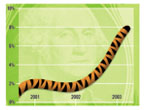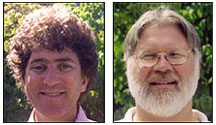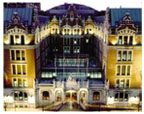November 19, 2003: Notebook
Endowment
gains 8.2 percent
Strong returns follow two years of modest growth

 Endowment
gains 8.2 percent
Endowment
gains 8.2 percent Strong returns follow two years of modest growth
The University’s endowment achieved an 8.2 percent return on investments in the fiscal year that ended June 30, lifting its value to a record high of $8.7 billion, according to Andrew Golden, president of the Princeton University Investment Company (Princo).
In Princo’s diversified portfolio, the year’s biggest winners included emerging-market investments, particularly in Russia, independent return managers, and fixed income. Private equities experienced minor losses, but Golden says they have still generated a “tremendous benefit” over the long term.
During the two previous years, when the world’s equity markets declined and most universities lost money, the Princeton endowment achieved modest gains (2.2 percent in 2002, and 2.4 percent in 2001). And while 2003’s increase does not approach the exceptional numbers of the late ’90s, Golden was pleased with the outcome in a volatile year.
“The important question is how well are you playing the hand that’s being dealt at that time,” Golden says. “In many ways, this year was as strong, if not stronger [than those in the late ’90s], in terms of the value being added through skill, rather than the value being created by very strong market tailwinds.”
According to the New York Times, Princeton’s endowment outperformed five other Ivy League institutions, but finished behind Harvard (12.5 percent return) and Yale (8.8 percent).
Princeton’s endowment funded 37 percent of the University’s
operating budget in the 2003 fiscal year. It is the largest per-student
endowment in the nation, and its total value ranks third among private
colleges, behind Harvard and Yale. ![]()
By B.T.

 |
Two acclaimed yet very different sociologists have joined Princeton’s faculty this fall. The arrival of Doug Massey *78, who left the University of Pennsylvania, and Mitch Duneier, from the University of Wisconsin–Madison, have helped lift Princeton’s sociology department in peer rankings.
“Princeton was one of the top 10 departments in the country,” says department chairman Alejandro Portes. “With the new additions, we should be in the contest for one of the top five slots.”
Sociology can be approached in several ways, and Massey and Duneier exemplify two different methods.
Massey, who studies immigration, housing, poverty, race, and international relations, employs scores of people to survey large numbers of people, track them over time, and compile and analyze data. His results influence public debate and policies affecting population subgroups, such as the poor or immigrants. He has testified before Congress, met with the president of Mexico, and briefed the U.S. secretary of housing and urban development.
Massey also holds an appointment with the Woodrow Wilson School: “I wanted to be in a place with a stronger policy presence, and I thought the Woodrow Wilson School would be a better platform for me to have an effect on policy debates in areas that I’m interested in.” Massey, a member of the National Academy of Science, is developing two courses for the spring, one on race and public policy and one on immigration and immigration policy.
Duneier, an urban ethnographer, is known for a more intimate approach.
He studies some of the same issues as Massey — poverty and race — by going directly to the field and becoming part of the group he’s observing. His most recent book, Sidewalk (1999), is a result of his having spent months, over the course of five years, among street vendors in New York’s Greenwich Village. In researching the book, Duneier worked as a vendor, slept on the sidewalk, and worked night shifts with low-wage workers.
Duneier’s work, like Massey’s, influences debate, because his books have gained a popular audience. Reviewers called Sidewalk “clear and compelling,” and a “necessary book,” saying it was a book that calls into question people’s assumptions about people living at society’s edge.
This fall Duneier is teaching a freshman seminar on the ghetto, an introductory
course on race and ethnicity, and a graduate seminar. ![]()
By L.O.

 |
|
David Coffin ’40 *54 Photo: office of communications |
David Coffin ’40 *54, an expert in Italian Renaissance landscape design and a longtime architecture professor at the University, died October 14. He was 85.
A prominent researcher and teacher, Coffin was remembered by colleagues as a trendsetter in the study of garden and landscape design, laying the foundation for current work in the field.
Coffin received an A.B. and an M.F.A. from Princeton before returning to join the faculty in 1949. He earned his Ph.D. in 1954. Coffin’s career included six years as the chairman of the art and archaeology department (1964—70), and during that time he helped plan major renovations of the Marquand Library of Art and Architecture. He also received the Howard T. Behrman Award for distinguished achievement in the humanities in 1982.
Coffin, who wrote two award-winning books before his retirement in 1988,
was prolific as an emeritus professor, publishing three books in a decade,
including a historical guide to Princeton’s Graduate College. His
final book, a biography of 16th-century Italian architect Pirro Ligorio,
is due to be published in January 2004.
![]()

 |
| Photo: John Jay College of Criminal Justice (john jay college of criminal justice) |
Princeton representatives visited the John Jay College of Criminal Justice in New York City this fall to induct the second batch of Justice Scholars, who each will receive $2,000 a year to attend John Jay as part of a program Princeton initiated and funded in response to the tragedies of September 11, 2001.
A quarter of the $1 million set aside for programs to respond to September 11 went to the Justice Scholarships, intended to honor the memory of the more than 100 John Jay students and alumni who died in the World Trade Center attacks.
Each year, the City University-affiliated school selects 10 scholarship winners — five incoming freshmen, and five current students. Forty-four students applied this year, up from 36 in the program’s first year. Winners receive $1,000 each semester (tuition for New York state residents is $2,000 a semester) for up to four years as long as they maintain a 3.5 grade point average. The only criteria are academic merit and dedication to public service. This year’s winners have participated in a range of community service programs from Toys for Tots to Meals on Wheels.
“They are really your strivers — they are looking to achieve and overcome day-to-day hardships,” says Princeton Alumni Association President Skip Rankin ’72, who spoke at the induction ceremony along with Vice President for Public Affairs Robert Durkee ’69.
In addition to high academic credentials, “they come from very diverse backgrounds,” says Durkee. “A number of them have overcome significant adversity. Many of them have already held a number of jobs, many come out of difficult family circumstances, and a lot of them have overcome language barriers.”
Forensic science major Samantha Sheppard, one of last year’s recipients, said the scholarship is a feather in the winners’ caps and has made faculty more accessible. “They’re more willing to have a conversation because they know who we are, they know we’re bright, and they’re willing to help us,” says Sheppard, whose ties with faculty helped her land a sought-after job as a math tutor at the college’s Learning Enhancement Center.
Rankin, a partner at the law firm Coudert Brothers in New York, is a mentor to Tabitha Berry, another of last year’s winners. Berry, a junior justice-studies major with a 3.94 G.P.A. who commutes to class from her home in Jamaica, Queens, hopes to pursue a Ph.D. in literature or history and perhaps, eventually, a law degree.
“When you look at my high school career and you look at my career at John Jay it’s a dramatic evolution,” says Berry, who didn’t get serious about academics until her junior year of high school, and who applied to the scholarship to lighten the financial burden on her single mother of two. “I’m a girl who some thought wasn’t as avid a student as others. I was sort of branded in a way. When I got the scholarship, I was really grateful, because I know where I come from.”
Berry accompanied Rankin to the Princeton Association of New York City inaugural event in Bryant Park September 30, where she met President Tilghman. Rankin hopes to hold events for all the scholarship winners at his firm and at the Princeton Club of New York, and to involve members of the New York alumni association in mentoring the students.
Princeton and John Jay originally hoped that the program would last
seven to 10 years. But, according to Durkee, John Jay is “actively
trying to raise funds that would sustain this program beyond the length
of time that the Princeton money will support it,” and has already
had some success. ![]()
By Zachary Pincus-Roth ’02
Zachary Pincus-Roth ’02 is a freelance writer living in New York City.

On November 21, Princeton will celebrate the life and work of poet Theodore Weiss, a former faculty member who died in April. A poetry reading will take place at the James M. Stewart Film Theater, and two films about Weiss and his work will be shown the next day. For more information, 609-258-4712.
Mercer County Superior Court has ordered mediation in the lawsuit filed
by members of the Robertson family against the University and four University-appointed
Robertson Foundation trustees, including President Tilghman. Charles Robertson
’26 and his wife, Marie, donated $35 million to support the graduate
program of the Woodrow Wilson School in 1961. The gift has since grown
to more than $500 million. The Robertsons’ son, William ’72,
was one of five relatives who filed suit in July 2002, disputing the University’s
plans for foundation assets and its record in placing students in government-service
careers. ![]()
